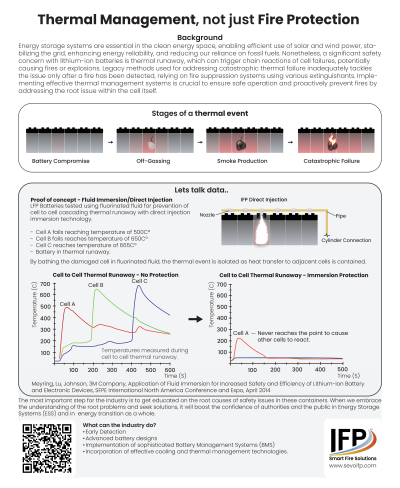Back

RE+ Tech
Proper Battery Protection – Thermal Management, not just Fire Protection
Tuesday, September 12, 2023
4:30 PM - 5:30 PM PDT
Location: Poster Area, Booth #11024, Level 1, Venetian Expo Hall

.jpg)
Todd Stevens
Operations Manager
SEVO Industrial FIre Protection
Lenexa, Kansas, United States
Poster Presenter(s)
Description and Background: With the proliferation of advanced, electric battery power, the industry has experienced a dramatic expansion of wind and solar power affecting all aspects of our lives. Not the least of which, with li Ion-based battery power, the hazard has fundamentally changed our safety in a way that is not clearly understood and thus protection is mis-applied. The thought is, when a battery pack fails and goes into thermal runaway, the solution is, until the battery stops having cells fail, firefighters use a combination of isolating the battery and protecting exposures.
Therein lies the problem, because a battery failing and going into thermal runaway is not a fire problem, it is a thermal management problem. How many times have we seen on the news or read about an energy storage facility catastrophically fail and be completely destroyed? Or a battery powered automobile engulfed in flames? To be clear, left unchecked, li-Ion batteries fail in a very violent way. And, if one treats this from a traditional fire protection standpoint, one is too late. One must stop the cascading transfer of heat from the initial, offending cell or cells at the micro-level and do so in a way where the battery can continue to operate and be safely shut down so that repairs may be made.
Research has proven the concept, reporting on a novel approach to mitigate this risk. Experiments showed that immersion of battery packs in dielectric fluid greatly reduced the maximum surface temperature of the initial cell with the internal short, no external combustion was observed, and the cell-to-cell cascading thermal runaway event was completely eliminated.
This session discusses extension of this existing technology and advancing on the work of reseachers, which aligns with successful efforts by battery manufacturers to develop micro protection schemes to stop thermal runaway. It also aligns NFPA 855, Standard for the Installation of Stationary Energy Storage Systems.
Therein lies the problem, because a battery failing and going into thermal runaway is not a fire problem, it is a thermal management problem. How many times have we seen on the news or read about an energy storage facility catastrophically fail and be completely destroyed? Or a battery powered automobile engulfed in flames? To be clear, left unchecked, li-Ion batteries fail in a very violent way. And, if one treats this from a traditional fire protection standpoint, one is too late. One must stop the cascading transfer of heat from the initial, offending cell or cells at the micro-level and do so in a way where the battery can continue to operate and be safely shut down so that repairs may be made.
Research has proven the concept, reporting on a novel approach to mitigate this risk. Experiments showed that immersion of battery packs in dielectric fluid greatly reduced the maximum surface temperature of the initial cell with the internal short, no external combustion was observed, and the cell-to-cell cascading thermal runaway event was completely eliminated.
This session discusses extension of this existing technology and advancing on the work of reseachers, which aligns with successful efforts by battery manufacturers to develop micro protection schemes to stop thermal runaway. It also aligns NFPA 855, Standard for the Installation of Stationary Energy Storage Systems.
